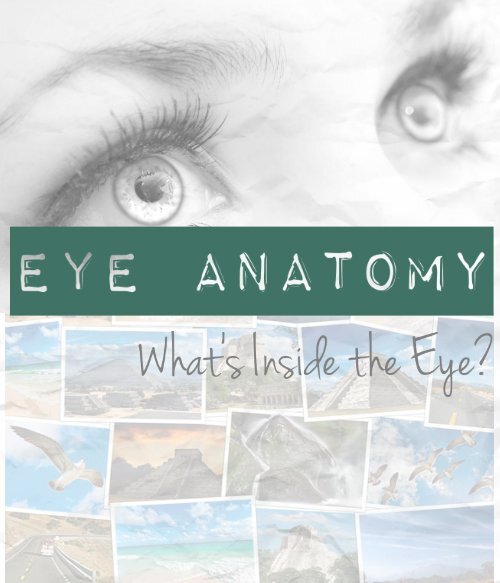You also want an ePaper? Increase the reach of your titles
YUMPU automatically turns print PDFs into web optimized ePapers that Google loves.
The eyes are wonderful enough and <strong>the</strong>y work like a camera. They<br />
can take pictures of <strong>the</strong> world and sends <strong>the</strong>m to <strong>the</strong> brain. The brain<br />
works out what <strong>the</strong> eyes see. This happens <strong>the</strong> moment you open<br />
your eyes in <strong>the</strong> morning and when you close <strong>the</strong>m at night. The eyes<br />
work in a similar way with a camera. The light passes through <strong>the</strong> lens<br />
and is being recorded on <strong>the</strong> back of <strong>the</strong> eye or <strong>the</strong> retina.
Cornea - A see-through skin that<br />
covers <strong>the</strong> front of <strong>the</strong> eyes. This is<br />
clear like a glass and has no blood<br />
vessels.<br />
<br />
Sclera - A tough skin that covers <strong>the</strong><br />
outside part of <strong>the</strong> eyeball. This is also called as <strong>the</strong><br />
white of <strong>the</strong> eye.<br />
<br />
Iris - This controls <strong>the</strong> amount of light entering <strong>the</strong> eye.<br />
This is also <strong>the</strong> colored part of <strong>the</strong> eye.<br />
<br />
Pupil - This is <strong>the</strong> hole in <strong>the</strong> colored part (iris). It lets<br />
light enter into <strong>the</strong> eye. It becomes very small in bright<br />
lights, and bigger in dull lights.<br />
<br />
The Lens - This focuses <strong>the</strong> light to <strong>the</strong> retina. Its shape<br />
changes in order to make sure that <strong>the</strong> picture on <strong>the</strong><br />
retina is clear.
T H E E Y E S
Retina - This is like a movie screen that shows <strong>the</strong><br />
picture you see. This has two lots of cells known as rods<br />
and cones. The rods see black and white. Cones see<br />
colors. These two turn <strong>the</strong> picture into an electrical<br />
message to <strong>the</strong> brain.<br />
<br />
Blind Spot - This a bit of <strong>the</strong> retina, which is not<br />
sensitive to light because it has no rods and cones. This<br />
is <strong>the</strong> spot where <strong>the</strong> optic nerve is joined to <strong>the</strong><br />
retina.<br />
<br />
Optic Nerve - This is where <strong>the</strong> messages from <strong>the</strong><br />
retina travel going to <strong>the</strong> brain. It is like a cable that<br />
carries <strong>the</strong> TV pictures from aerial to <strong>the</strong> TV so you can<br />
see <strong>the</strong> programs.<br />
<br />
<strong>Eye</strong>lids and <strong>Eye</strong>lashes - They protect <strong>the</strong> eyes. The<br />
eyelids shut out light so a person can sleep. They will<br />
also shut off fast when <strong>the</strong>y feel that something is<br />
trying to get into <strong>the</strong> eye. <strong>Eye</strong>lashes on <strong>the</strong> o<strong>the</strong>r hand,<br />
are very sensitive, and when <strong>the</strong>y feel that dust is<br />
coming, <strong>the</strong>y trap it as <strong>the</strong> eyelid closes.
<strong>Eye</strong>brows - They help keep sweat and dust out of <strong>the</strong><br />
eyes<br />
Tear Glands - These are small glands inside <strong>the</strong> upper<br />
eyelid. They produce tears to keep <strong>the</strong> surface of <strong>the</strong><br />
eyeball moist and clean and protect it from damage.<br />
When you blink, <strong>the</strong> eyelids spread <strong>the</strong> tears over <strong>the</strong><br />
surface of <strong>the</strong> eye.<br />
Conjunctiva - A thin lining inside <strong>the</strong> eyelid and <strong>the</strong><br />
outside of <strong>the</strong> front of <strong>the</strong> eye. It has some tiny blood<br />
vessels over <strong>the</strong> eye. When <strong>the</strong> eyes get sore, <strong>the</strong><br />
blood vessels become bigger and <strong>the</strong> eyes look red.<br />
Ciliary Muscles - These are circles of tiny muscles<br />
around <strong>the</strong> lens. They change <strong>the</strong> shape of <strong>the</strong> lens by<br />
relaxing and squeezing. Relaxing means making <strong>the</strong><br />
lens thinner for far away objects, while squeezing is<br />
making <strong>the</strong> lens fat to look at nearby objects.<br />
<strong>Eye</strong>s are amazing and it is our responsibility to look after<br />
<strong>the</strong>m carefully. We can undergo eye examinations and<br />
wear protective accessories to ensure <strong>the</strong> health and<br />
protection of our eyes. Keeping ourselves informed<br />
through https://twitter.com/Mississauga<strong>Eye</strong> is essential to<br />
prevent any potential eye problems.




